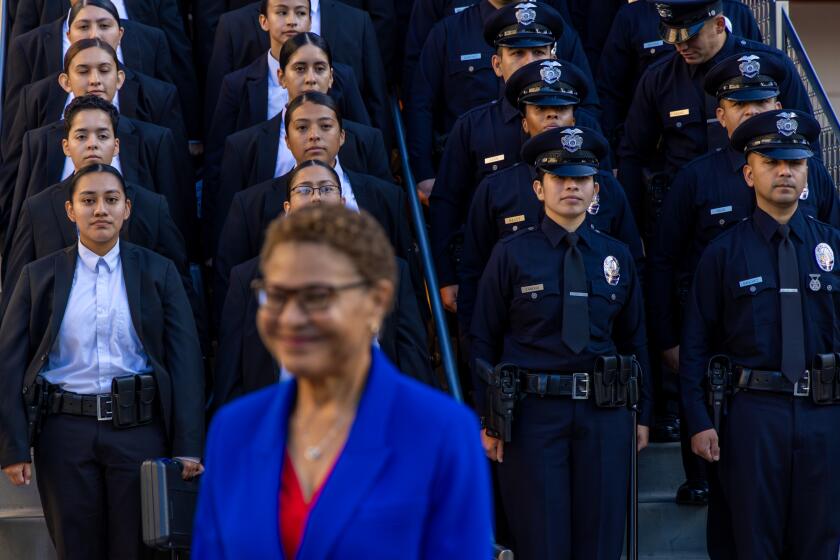Baby Death Suit Response Raises Questions : Health care: The county has not investigated the claim that Olive View hospital in Sylmar was at fault.
- Share via
A 15-year-old mother’s claim that negligence at the county’s Olive View Medical Center cost the life of her baby led not to an investigation of the truth of the claim, but to a hard-nosed legal defense.
In a blizzard of legal documents, the Pasadena law firm hired by Los Angeles County has sought to raise doubts about whether the baby who died Feb. 5, 1990, was really the one born in the Sylmar hospital five days earlier. It has also fought demands by the girl’s lawyer to produce evidence bolstering that contention, collecting $40,000 in legal fees along the way.
But a review of the voluminous file in the Los Angeles County Superior Court lawsuit shows that the county has offered no explanation of what happened other than the possibility that the girl took home her healthy baby and several days later brought another, already gravely ill infant to Northridge Hospital Medical Center. The infant died several hours after emergency surgery to repair tears in its bowel tract brought about by an undiagnosed birth defect.
The county has not exhumed the body and spent the $1,500 to $2,000 medical experts say it would cost to perform a DNA test to show conclusively whether the girl, Patricia Chavez of Northridge, was its mother. It also has not interviewed the family or friends of Chavez, now 17, or her boyfriend, Reynaldo Ruiz, 21, for evidence that the original child is still alive.
After published reports about the lawsuit appeared this week, County Supervisors Mike Antonovich and Gloria Molina asked administrators to review the handling of the case by Olive View and the county’s law firm.
In response, Robert C. Gates, the county’s top health official, issued a memo saying that the “attorney representing the county is still fact finding” and has “not taken a position” on the identity of the dead child.
In legal documents, however, the county’s attorneys state: “To the best of defendant’s knowledge baby boy Chavez . . . born to Patricia Chavez . . . was not” the child who died.
Questioned about the apparent differences in the county’s position, the Los Angeles County counsel’s office acknowledged this week that the switched-baby defense has not been thoroughly investigated. But county officials refused to discuss the case in detail because it is the subject of litigation.
The claim against the county concerns a facility where the exploding volume of births--mostly to poor mothers--was described last fall in hospital documents as “an internal disaster.” Since 1987, the annual number of births at the hospital has jumped by 193% and caused officials to reduce from two to one the number of times babies are examined by a doctor before their release.
Dr. Douglas S. Frasier, the hospital’s chief of pediatrics, acknowledged in an interview last fall that “the potential of having a baby go home and die or come back and die is quite real.”
Steven Antonio Ruiz died when his heart stopped at Northridge Hospital Medical Center during emergency surgery. Doctors there and later at the Los Angeles County coroner’s office reported that the cause of death was an undiagnosed congenital defect known as VATER syndrome.
It is a condition affecting one in every 8,000 babies. Frequent symptoms include defects of the kidneys, vertebrae and anus, all of which the infant had, according to a coroner’s autopsy.
Chavez and her attorney contend that doctors and nurses at Olive View failed to notice the condition and that the child died as a result. Medical experts said the condition could have been easily corrected if diagnosed earlier.
Aileen Norvell Goldstein, a Burbank attorney representing Chavez, said the county’s failure to investigate its claim of a baby switch has placed the unfair burden on her client to prove that the baby she and her family scraped together $838 to bury was the same as the one pictured in happy photographs taken at Olive View.
“They’re supposed to find out the truth and defend on the truth,” Goldstein said. “How can they subject that little girl to that kind of questioning and then say, ‘We’re not sure’ ” of the baby’s identity.
She is suing the county for $250,000 plus punitive damages and damages caused by what she says is the county’s malicious defense involving the switched-baby theory.
Born with a head of thick black hair, the child known on Olive View medical records as baby boy Chavez appeared normal, twice scoring nine out of a possible 10 on the Apgar scale that evaluates newborns’ maturity.
Over the next two days at the hospital Chavez would show off her chubby son to a variety of relatives and friends in between changing wet diapers and trying to get the baby to breast-feed, according to her deposition. Diane Whittaker, a nurse who spent several hours in the room in the course of a shift, would later describe the atmosphere there as “very happy, joyous,” with the many relatives around offering support.
Once home, however, the child cried almost constantly and began vomiting a greenish fluid, Chavez said. She took her baby back two days later to Olive View where blood was drawn and they returned home. The next day, Chavez rushed the child--its heart no longer beating--to Northridge Hospital. The child was revived and emergency surgery to repair internal damage was unsuccessful.
Because it was obvious that the baby’s condition had gone undiagnosed, hospital personnel advised Chavez to consult an attorney about a lawsuit, Goldstein said.
Dr. Arnold Platzker, head of the neonatology division at Childrens Hospital Los Angeles, and an expert on VATER syndrome, said the most obvious sign of the disorder is an absence of bowel movements. He said it is not always possible to detect whether an anus is dysfunctional on visual inspection alone.
The notations on the baby’s medical chart at Olive View show that at least one nurse and one doctor had seen a normal anus and that at least two nurses reported that bowel movements had occurred. After the death, those records led to rumors about the true identity of the dead child, according to a county source familiar with the case.
But one of those two nurses said in a deposition taken as part of the lawsuit that her note referring to a bowel movement may have been based on secondhand information, either from the mother or from other notations on the chart. The other nurse has not yet answered questions in the case because her identity has not been determined.
When asked in legal papers to prove their claim of a baby switch, the county’s attorneys repeatedly refer to apparent discrepancies between the autopsy report and Olive View records on the newborn.
The autopsy report on the dead child established the baby’s weight as about three ounces heavier than when it left the hospital and its length as the same. Another notation in the autopsy report put the length at 1 1/2 inches longer--although the deputy coroner who reported that figure said in a deposition that her technique often results in longer measurements.
The county’s attorneys have also sought to raise doubts by noting that the baby’s name varies on several documents--Steven Antonio Ruiz on one and Esteban Antonio Ruiz on another. Esteban is Spanish for Steven.
The county also notes that Chavez used two different addresses--her parents’ and the nearby apartment where she lives with her boyfriend.
In addition, the county’s attorneys say Olive View’s records and the autopsy report differ as to a birthmark on the baby’s buttocks.
Thomas V. O’Hagan, an attorney for Medical Specialists Temporary Personnel, one of three nursing registries also named in the lawsuit, said the case for a switch is bolstered by an ultrasound exam taken when Chavez was eight months pregnant that, he says, shows the fetus had two kidneys. The autopsy report on the dead infant noted that it had one kidney.
But Platzker, the Childrens Hospital neonatologist, and other experts said ultrasounds are sometimes difficult to interpret, even by radiologists.
Goldstein said she learned about the switched-baby theory from a private consultant the county hires to evaluate its risks when sued. Unlike the city of Los Angeles and many other public agencies, the county usually does not investigate legal claims internally before turning them over to consultants and outside law firms.
Bill Pellman, senior assistant county counsel, said his office has not independently investigated the Chavez case. But he said the risk consultants, Private Risk Management of Long Beach, typically conduct a “fairly thorough investigation” before making a recommendation to the county.
Neither Edward Benveniste of Private Risk Management nor Leonard E. Torres of Torres & Brenner, the law firm handling the county’s case, will discuss the steps they took to determine the truth of Chavez’s claim before arguing that the babies had been switched.
After a request from Antonovich, county Chief Administrative Officer Richard B. Dixon this week ordered an investigation into Olive View’s procedures for handling newborns.
“We want to ascertain if there are weaknesses in our system, and if there are, to put in place measures that would correct them,” Dixon said. “We will be looking at the standard procedures of the hospital to see if they are adequate and look at the documentation in this case to see if the standard policies in this case were followed.”
“Nothing is going to unfortunately undo what has happened in this case,” Dixon continued. “Our concern has to be that similar tragedies aren’t repeated.”
More to Read
Sign up for Essential California
The most important California stories and recommendations in your inbox every morning.
You may occasionally receive promotional content from the Los Angeles Times.










